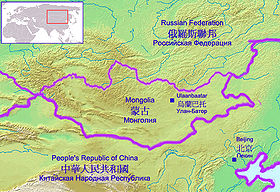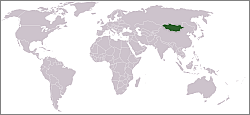Mongolia
| Монгол Улс Mongol Uls |
||||||
|---|---|---|---|---|---|---|
|
||||||
| Motto: none | ||||||
| Anthem: Монгол Улс |
||||||
| Capital (and largest city) | Ulaanbaatar 47°55′N 106°53′E | |||||
| Official languages | Mongolian | |||||
| Government | Parliamentary democracy | |||||
| Independence | ||||||
| Area | ||||||
| - | Total | 1,564,116 km² (18th) Expression error: Unexpected div operator. sq mi |
||||
| - | Water (%) | 0.6 | ||||
| Population | ||||||
| - | 2004 estimate | 2,791,272 (134th) | ||||
| - | 2000 census | — | ||||
| GDP (PPP) | 2005 estimate | |||||
| - | Total | $5.230 billion (151st) | ||||
| - | Per capita | $2,046 (146th) | ||||
| Currency | Tugrug (MNT) |
|||||
| Time zone | (UTC+7) | |||||
| - | Summer (DST) | (UTC+8) | ||||
| Internet TLD | .mn | |||||
| Calling code | +976 | |||||
Mongolia is a landlocked nation in central Asia, bordered by Russia to the north and the China to the south. It was the center of the Mongol Empire of the 13th century, but was ruled by the Manchu Qing dynasty from the end of the 18th century until an independent government was formed with Soviet assistance in 1921. Following the fall of the Soviet Union, Mongolia adopted electoral politics. The 18th-largest country in the world by area, Mongolia has very little arable land: much of its area is grassland, with mountains in the north and west and the Gobi Desert in the south. A little over 30 percent of the population are nomadic or semi-nomadic Tibetan Buddhists of the Mongol ethnicity. Over 50% of the population reside in the capital city Ulaanbaatar.
History
In the 13th century, Mongolia was the center of the Mongol Empire, the largest contiguous land empire in world history. After more than a century of power, the Mongol Empire ended and Mongolia fell back into a state of internal struggle and feuds, which paved the way for the Manchu conquest of Inner Mongolia in 1636 and the submission of Outer Mongolia in 1691. Both Inner and Outer Mongolia declared independence in 1911, but only Outer Mongolia succeeded, with Russian help. After the October Revolution in Russia, Chinese troops re-occupied Outer Mongolia in 1919, but were caught in the middle when White and Red Russian armies extended the Russian Civil War into (Outer) Mongolian territory, and were driven out in 1921. In 1924, the Mongolian People's Republic was proclaimed. Mongolia was aligned closely with the Soviet Union. Politicians who demanded a more independent course, like Bodoo or Dandzan, were quickly toppled and executed. In 1928 Horloogiyn Choybalsan rose to power. Under his rule, forced collective farming, purges, and the destruction of the Lamaist monasteries in 1937 left more than 10,000 people dead.
During World War II, the USSR defended Mongolia against Japan during the Battle of Halhin Gol. Mongolian forces also took part in the Soviet offensive against Japanese forces in Inner Mongolia of August 1945 (see Operation August Storm). The threat of Mongolian forces seizing parts of Inner Mongolia induced the Republic of China to recognize Outer Mongolia's independence, provided that a referendum was held. The referendum took place on October 20, 1945, with, according to official numbers, 100% of the electorate voting for independence. After the establishment of the People's Republic of China, both countries recognized each other on October 6, 1949.
After Choybalsan died in Moscow on January 26, 1952, Yumjaagiyn Tsedenbal took power. In 1956 and again in 1962, Choybalsan's 'personality cult' was condemned. Mongolia continued to closely align itself with the Soviet Union, especially after the Sino-Soviet split of the late 1950s. While Tsedenbal visited Moscow in August 1984, being very ill, the parliament announced his retirement and replaced him with Jambyn Batmonh.
In 1990, the Communist Party relinquished control over the government, paving the way for a new constitution in 1992 that abolished the People's Republic and created a hybrid parliamentary/presidential state.
Politics
Until June 27, 2004 the predominant party in Mongolia was the Mongolian People's Revolutionary Party or MPRP, which was formed by Mongolia's communist leaders after the end of the Cold War. The main opposition party was the Democratic Party or DP, which controlled a governing coalition from 1996 to 2000. From 2000 to 2004 MPRP was back in power, but results of the 2004 elections required the establishing of the first ever coalition government in Mongolia between the MPRP and MDC (Motherland Democratic Coalition). The state employs a dual executive system with an elected president as head of state and a prime minister as head of government. The legislature, or State Great Khural, has one chamber with 76 seats and is chaired by the speaker of the house.
Geography

The Mongolian heartland consists of relatively flat steppes. The southern portion of the country is taken up by the Gobi Desert, while the northern and western portions are mountainous. Uvs Nuur Lake, shared with Tuva Republic of the Russian Federation, is a natural World Heritage Site.
Most of the country is hot in the summer and extremely cold in the winter, with January averages dropping as low as -30°C (-22°F). The country is also subject to occasional harsh climactic conditions known as zud or dzud.
Ulaanbaatar has the coldest average temperature of any national capital in the world.
Economy
Mongolia's economy is centered on agriculture and mining. Mongolia's main mining products are petroleum, coal and copper, with smaller industries in molybdenum, tungsten, and phosphate mining. Following decades of state-run enterprise, the economy has undergone an often-painful transition to capitalism; many industrial facilities were closed down with the end of the Soviet Union, which supported the largely loss-making factories. There are currently over 30,000 independent businesses in Mongolia, chiefly centered around the capital city. The majority of the population outside the cities subsists on sustenance herding; livestock typically consists of cows, sheep, goats, horses and Bactrian camels.
GDP per capita is about $602 in nominal terms, but adjusted for purchasing power this comes to around $2,046. Although GDP has risen steadily since 2002, the state is still working to overcome a sizable trade deficit. A massive ($11 billion) foreign debt to Russia was settled by the Mongolian government in 2004 with a $300 million payment; this reduced value was accepted due to Mongolian hardship and losses of human lives during the Soviet Era. Mongolia joined the World Trade Organization in 1997 and now exports cashmere, minerals, and food products to Russia, the United States, China, Japan, Italy, and other countries.
Demographics
Most Mongolians are Mongol in descent: there are also smaller populations of Kazakh and Tungus people. The predominant religion is Tibetan Buddhism. As in many developing countries, Mongolia's young and rapidly growing population has put great strains on its economy.
Culture
General
- CIA World Factbook - Mongolia
- Country Studies - Mongolia offers background information on Mongolia
- Dmoz - Mongolia Links
- Plants of Mongolia
- Mongolia Gateway portal
- Mongolia Today Magazine
- Mongolian Open Government (in Mongolian and English)
- Mongolian Tourist Board
- Mongoluls.net - Information on Mongolia
- Mongolia and Social Development
- The UB Post Mongolia's Independent English Weekly News
- 21 Days In Mongolia Backpacking in Mongolia
- Collection of pictures from Mongolia sorted by province
- Photo session In Mongolia Mongolia photo
- Tourism In Mongolia Tourism In Mongolia
- Travel guide to Mongolia
Credits
New World Encyclopedia writers and editors rewrote and completed the Wikipedia article in accordance with New World Encyclopedia standards. This article abides by terms of the Creative Commons CC-by-sa 3.0 License (CC-by-sa), which may be used and disseminated with proper attribution. Credit is due under the terms of this license that can reference both the New World Encyclopedia contributors and the selfless volunteer contributors of the Wikimedia Foundation. To cite this article click here for a list of acceptable citing formats.The history of earlier contributions by wikipedians is accessible to researchers here:
The history of this article since it was imported to New World Encyclopedia:
Note: Some restrictions may apply to use of individual images which are separately licensed.


